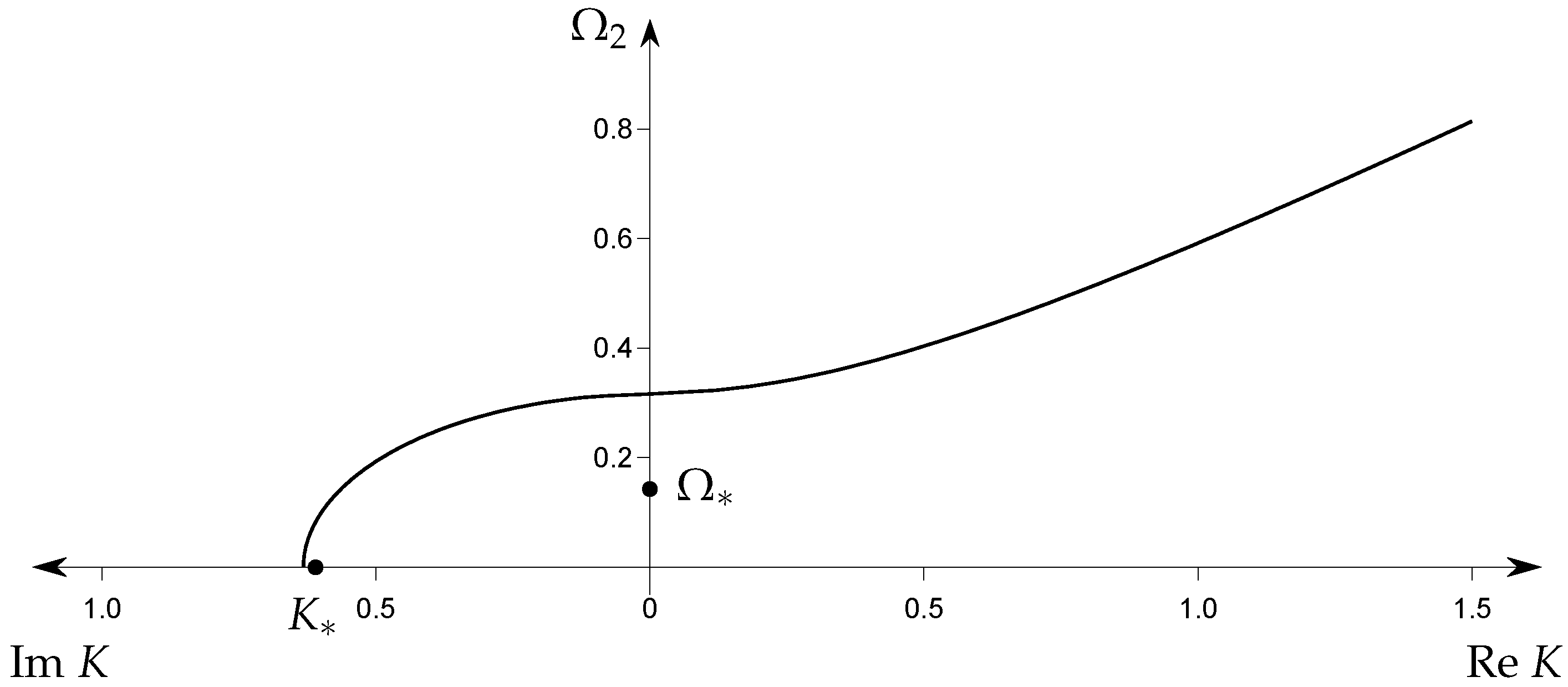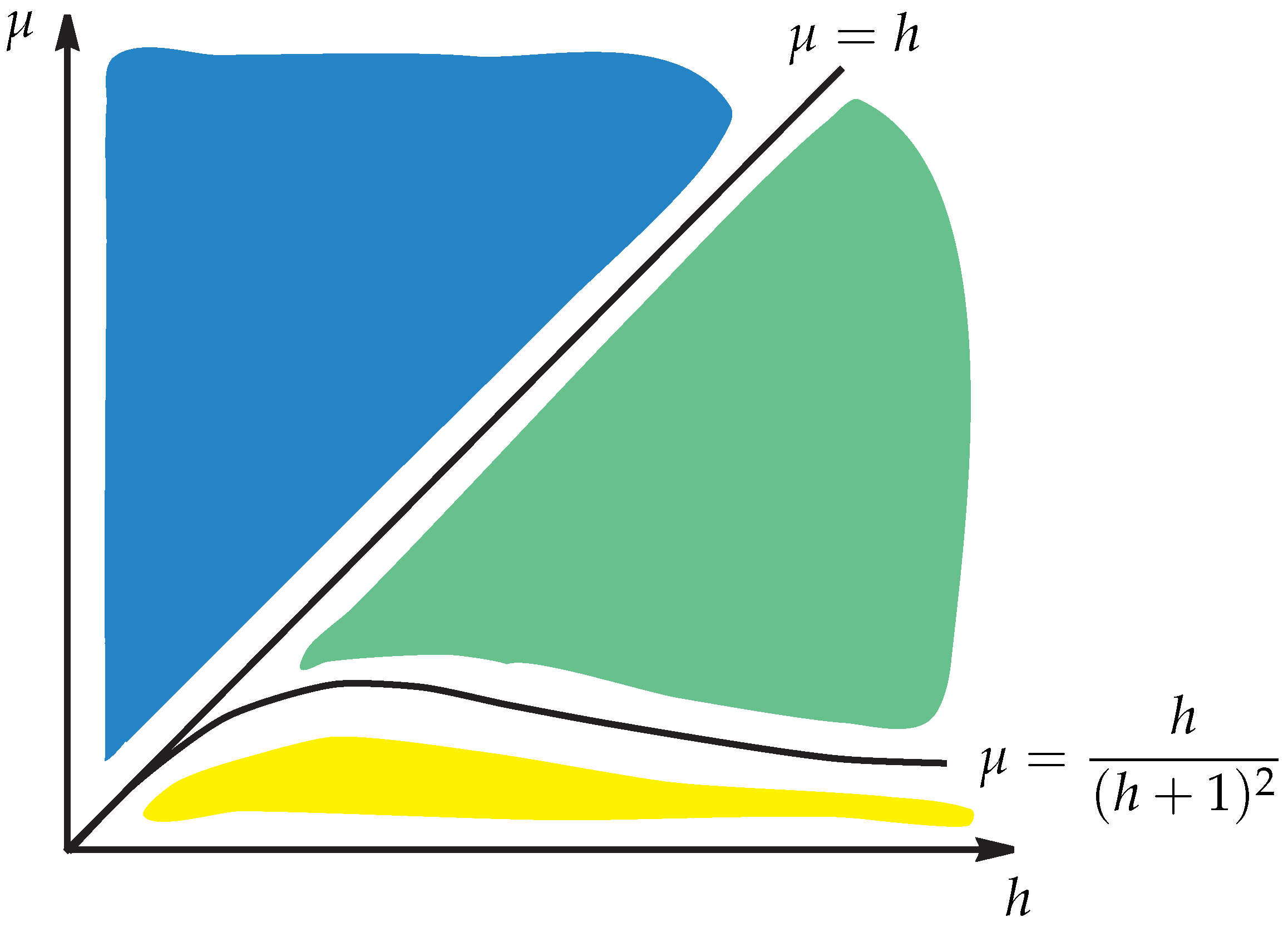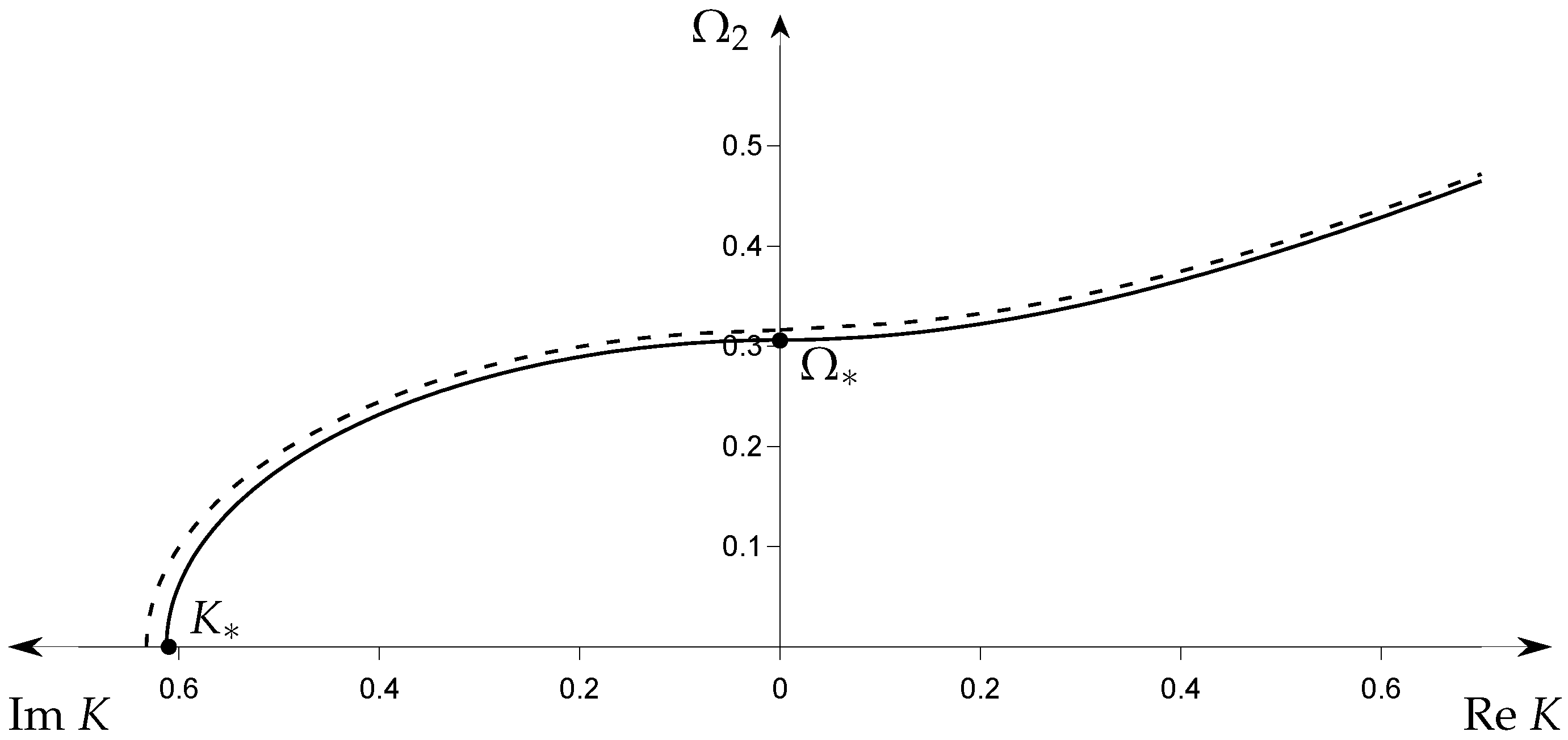1. Introduction
The mathematical modelling of layered elastic structures has been a subject of numerous publications; see, e.g., [
1,
2,
3,
4] and references therein. More recently, a growing interest in high-contrast laminates has been inspired by modern important applications, including laminated glass, photovoltaic panels, lightweight sandwich-type structures; see, e.g., [
5,
6,
7,
8]. In addition, we mention the related contributions [
9,
10,
11].
Two of the most significant observations regarding high-contrast layered structures include a degeneration of the boundary layers, demonstrating slow decay into the interior, studied in [
12,
13,
14,
15], along with the emergence of a specific low-frequency shear vibration spectra, characterised by a small cut-off frequency with the value tending to zero as powers of small parameters standing for contrast (see [
16]) treating three-layered symmetric papers for several mechanical and geometrical setups; see also [
17]. The eigenvalue problem on the plate’s transverse cross section also arises in the case of free longitudinal vibrations of a strongly inhomogeneous, three-component rod [
18]. The presence of an extra low-frequency shear mode supports two-mode long-wave low-frequency asymptotic theories for asymmetric three-layered strips, subject to antiplane elastic deformation; see [
19]. The cited paper also suggests a non-trivial asymptotic generalisation of Saint-Venant’s principle for the considered high-contrast scenario, stating the consistent boundary conditions (see also [
20]) for extension to the anti-plane shear of multi-layered structures. The extra approximate boundary condition in [
19] ensures the equilibrium of stress couples applied along the contour of a soft layer. The number of extra asymptotic boundary conditions in [
20] coincides with that of soft layers and may be interpreted in a similar manner.
The relation between the degenerated boundary layers and the extra low-frequency modes has not yet been studied systematically, with the exception of [
19], addressing only one specific parametric setup. At the same time, the static analysis in [
12,
13,
14] is mainly restricted to studying the roots of the related transcendental equation without a more general insight into the peculiarities of the stress and strain fields. The main objective of the present paper is elucidation of the link between these two phenomena. Enhanced understanding of this link is relevant for new technological advances over virtually all of the above-mentioned applications, including modern sandwich panels.
A basic example of the antiplane problem in dynamic elasticity for a three-layered high-contrast symmetric laminate with Neumann boundary conditions on the faces is considered. The results of the full multiparametric analysis are presented for the antisymmetric low-frequency wave. In this case, the ratios of thicknesses, stiffnesses and densities of the layers are assumed to be independent of each other. The tackled example clearly illustrates a multiscale nature of the high contrast effect. Indeed, it brings an extra relatively large length scale (compared to thickness) corresponding to a degenerate boundary layer, as well an extra time scale (small compared to the time elastic waves take to propagate the distance of order thickness) associated with the lowest cut-off, in addition to laminate thickness. Obviously, the aforementioned length and time scales do not arise in non-contrast situations.
It is established that the extra low-frequency modes do not always accompany the degenerate boundary layers. It is shown that both uniform and non-uniform approximations of the associated dispersion curve are possible. The asymptotic bounds on the problem parameters, corresponding to various options are found. Numerical illustrations are presented.
Another emphasis of the paper is on the explicit solution of the forced problem for a semi-infinite symmetric three-layered strip with traction-free faces under a self-equilibrated edge stress. The decay condition in [
19] generalising Saint-Venant’s principle is adapted. Above the cut-off frequency, this transforms to a radiation condition aimed at excluding the long-wave propagating mode; see [
21] for more detail. As a result, the amplitude of the mode of interest is found. In addition, the peculiarity of the implementation of the limiting absorption principle for layered structures is briefly addressed for the long propagating mode originating from the cut-off in question. Along with the analysis of the coexistence of slowly decaying boundary layers and low-frequency vibration modes, this also contributes to the novelty of the paper.
The paper is organised as follows. The problem is formulated in
Section 2 with the dispersion relation and the associated eigensolutions derived in
Section 3.
Section 4 is concerned with multiparametric analysis of the dispersion relation. The main result of the paper addressing the general issue of the relation between the degenerated boundary layer and the low-frequency cut-off is also exposed in this section. The explicit solution to the forced time-harmonic problem for a semi-infinite three-layered strip is obtained in
Section 5. Several concluding remarks are summarised in
Section 6.
2. Problem Statement
Consider a semi-infinite, three-layered, symmetric, elastic laminate; see
Figure 1. Let the horizontal axe pass through the middle of the inner layer. Then, the latter occupies the domain
, whereas the outer skin layers are located at
. Below, we focus on antiplane shear motion, with the displacement field given by
, more specifically, on an antisymmetric problem, for which the out-of-plane displacement satisfies
.
The wave equations of motion are written conventionally as
where
is the two-dimensional Laplacian in
and
, and the transverse wave speed
c is defined as
Here,
and
stand for the shear moduli and volume mass densities of the core and skin layers, respectively.
The traction-free boundary conditions at the faces
are assumed, i.e.,
while the perfect contact conditions along the interfaces
are formulated as
where
indicate jumps of the associated quantities.
Here and below, the stresses
are given by
In addition, let a shear edge loading be modelled by the boundary condition
at
, where
is a prescribed stress, being an odd function in
, for the sake of simplicity, in order to exclude the fundamental mode from the consideration. At infinity
, we impose decay or radiation conditions on the sought-for solution.
The formulated problem has a clear multiparametric nature, characterised by several dimensionless parameters, including the relative stiffness, density and thickness, given by
Below all of them are assumed to be independent unless specified otherwise. The problem apparently provides the simplest step forward from 1D analysis in [
18] to a 2D setup.
3. Dispersion Relation
First, we introduce the travelling wave ansatz for the displacement in the form
where
k and
conventionally denote the wave number and angular frequency, respectively, and
is a sought for odd function; hence, below, we may restrict ourselves to the interval
.
Then, we infer from (
1) that
where
is the dimensionless transverse variable;
,
and
are arbitrary real constants; and the parameters
and
are defined by
with
standing for the dimensionless wave number and frequencies, respectively.
Next, inserting (
8) and (
9) into boundary and interfacial conditions (
3) and (
4), we arrive at the dispersion relation
The eigenform amplitude
is then given by
where
C is an arbitrary constant.
In what follows, we consider the long-wave low-frequency behaviour of this dispersion relation, assuming that
This setup has been earlier defined as a global low-frequency one (see [
18]), since it is associated with polynomial variation of the sought-for displacement field across the thickness within each of the layers. The absolute value of
K in (
15) indicates that both propagating and evanescent modes are studied.
4. Multiparametric Analysis
Below, the dispersion relation (
13) is subject to asymptotic analysis in three independent parameters (
7) over the long-wave low-frequency domain (
15). As mentioned above, the focus is on the relation between the two most importance consequences of high contrast, namely the degeneration of boundary layers and the shift of cut-off frequencies to the low-frequency domain. It is worth noting that the latter are related to specific extra scales, including a large length scale and slow time scale, respectively. For these scales, a typical decaying rate is much greater than the laminate thickness, and a characteristic time considerably exceeds that elastic waves take to propagate the distance between laminate faces.
Consider first the static limit at
. In this case, the transcendental equation has small imaginary roots
where, at leading order,
provided that
In contrast to homogeneous structures, the root
corresponds to the so-called degenerated boundary layer, which does not decay at the distances of order thickness away from the edge. The asymptotic behaviour (
16) was earlier established in [
12]. However, the two-parametric origin of the problem was not taken into consideration; namely, it was supposed that
. As a result, the restriction (
17) has not appeared in the cited paper.
Next, turn to the asymptotic analysis of the lowest cut-off frequencies, coming from the dispersion relation (
13) at
. In this case, the aforementioned global low-frequency regime
takes place over the following parameter range:
see [
16,
18] for more detail. Then, for the sought-for cut-off frequency
or
It might be easily verified that a non-contrast setup, for which , does not support low-frequency cut-offs.
Let us now investigate the inequalities (
17) and (
18) simultaneously. First of all, it is clear that for
, i.e., excluding the laminates with thin skin, the condition (
18) guarantees not only a low cut-off, but also a slowly decaying static boundary layer. More generally, both phenomena occur when
In particular, for
, i.e., for conventional sandwiches with thin skin, the low-frequency vibration mode appears along with the strongly localised static boundary layer (typical of homogeneous or weakly inhomogeneous structures), provided that
Next, by taking leading-order Taylor expansions, we derive a shortened form of the dispersion relation (
13). It is given by
or, equivalently,
As might be expected, the last equation implies the values of
at
, and also
at
, which is in agreement with the estimates (
16) and (
19), respectively. Moreover, it is obvious that the approximation (
24) of the full dispersion relation is uniformly valid over the domain
provided that the conditions (
17) and (
18) are satisfied. The shortened dispersion relation (
24) also shows that the quasi-static limit occurs at
.
At the same time, above the cut-off frequency, the validity range of the approximation (
24) is given by
and
These strong inequalities generalise earlier considerations for one-parametric setups in [
16,
19].
Let us now present several graphical illustrations highlighting the observations above. First, we present a sketch characterising the domains corresponding to conditions (
17) and (
18) in parametric space. For the sake of clarity, we present a 2D graph in
and
h only, but bearing in the mind the restriction
, which is assumed to be valid. The highlighted domains in
Figure 2 correspond to various ranges of the dimensionless parameters
and
h, defined by the conditions (
17) and (
18), for which the latter are either satisfied simultaneously (yellow), or the relation (
18) holds but (
17) is violated (green), or when both (
17) and (
18) fail (blue).
Now, let us illustrate the case of a small cut-off frequency along with a rapidly decaying boundary layer, i.e., when the the strong inequalities (
18) are satisfied but condition (
17) is violated. It is clearly seen from
Figure 3, displaying the approximate curve (
24) covering both domains of the real and imaginary wavenumber
K. The approximate value in the static limit at
and
on the approximate curve (
24) is far off from the numerical solution of the exact dispersion relation (
13) at
,
. At the same time, the approximate curve is clearly passing very close to the exact point of the cut-off frequency
,
.
An opposite scenario is presented in
Figure 4, in which the parameters
,
and
are chosen such that the condition (
17) is satisfied, and the inequalities (
18) do not hold. Consequently, it is observed that the approximate curve (
24) passes close to the static limit
, but misses considerably on the cut-off frequency
.
Finally, we are displaying the setup when both conditions (
17) and (
18) are satisfied; see
Figure 5. In this case, the approximate curve (
24) is shown by a dashed line and is complemented by the exact dispersion (
13), depicted by solid curve. It is also remarkable that approximation (
24) provides a uniform approximation both for decaying and propagating modes.
5. Forced Vibration
Consider now time-harmonic forced vibration of a semi-infinite laminate, starting from the formulation in
Section 2. For the sake of simplicity, restrict ourselves to a one-parametric scenario in which
,
and
. In this case, as follows from (
14), the leading-order behaviour of the eigenform becomes
To determine the constant
C, we adapt the decay conditions in [
19,
20], generalising the classical Saint-Venant’s principle for high-contrast laminates. For a three-layered symmetric structure excited by a prescribed (self-equilibrated) shear edge stress
, an appropriate asymptotic condition becomes
This condition ensures the static equilibrium of the soft layer with respect to stress couples applied to both its edge and interfaces; in doing so, the first and second terms in (
29) correspond to the contributions of edge
and interfaces
,
, respectively. In fact, this condition is also applicable at leading-order to low-frequency vibration, see [
22]. Below, the factor
is assumed to be omitted. Note that for the frequencies above the cut-off
, this condition becomes a radiation one, prohibiting long-wave propagating modes; see [
21].
Let us now implement the substitution
in (
29), where
is calculated from (5) starting from the leading-order eigenform (
28). This guarantees rapid decay (at the scale of the thickness) of the boundary layer corresponding to the discrepancy between the given edge load
and the stress
associated with the low-frequency mode of interest. As a result, we arrive at
The related wave number in the exponential term in (
8) is approximated from (
24) by
below the cut-off, and
above the cut-off, where
The last expression satisfies the Sommerfeld radiation principle, also giving room for the simple implementation of the alternative limiting absorption principle; see [
23,
24] and references therein. To this end, we assume in (
34)
where
. As a result,
It may be seen from the latter that when
,
hence, on the cut-off frequency only the absorption over the soft inner layer appears in the expression for
. Clearly, for low-frequency propagating modes (with frequencies above the cut-off) the absorption in both soft and stiff layers needs to be taken into consideration. At the same time, as in most of the cases, the results coming from Sommerfeld and limiting absorption principles agree with each other.











